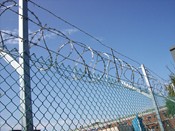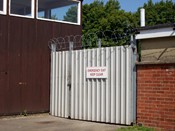|
Saturday 6th June 2009

Still in regular use - see "The waste recycling banks . . . "
One of the great cultural occasions for Bourne in recent times was an
exhibition of Tudor furniture which was held at the Red Hall over thirty years
ago and attracted immense interest throughout the town and county. It was held
at the long gallery and brought together a large collection of interesting and
valuable items from private owners and museums together with a number of
hand-woven silk damasks and brocades.
The subject of the exhibition was chosen because the Red Hall dates from circa
1605 and is typical of those built for prosperous gentlemen of the early Stuart
period and most probably designed by John Thorpe (1565-1655), one of the
foremost architects in Britain during the time of Elizabeth I. It is one of the
town’s oldest surviving secular properties, being Grade II listed in July 1977,
and is now used almost solely as offices for Bourne United Charities which
administers money left by various people in past times for the benefit of the
town.
The display included an Elizabethan court cupboard, a cabinet and two hall
chairs, a linen fold and screen, and a Jacobean press. Also gracing the gallery
was an Elizabethan tapestry loaned by the Earl of Ancaster while other items
came from St James’ Palace, Hampton Court and the Towneley Hall art gallery and
museum at Burnley, Lancashire. Other articles were brought in by local people
including the copy of a chair now in the Victoria and Albert Museum made by Jack
Rayner, woodwork master at Bourne Grammar School, and a collection of Coalport,
Derby, Staffordshire and Sunderland pottery and porcelain from the late Tom Jones, the
local antiques dealer.
There was also an art exhibition staged by pupils from Bourne Grammar and the
Abbey Primary Schools under the direction of art master Rod Hoyle and recent
finds from local excavations were brought in by the South Lincolnshire
Archaeological unit, pottery made in Bourne during the Middle Ages and old maps
of the town and Eastgate areas together with photographs and artefacts of the
steam railway age together with other miscellaneous displays by the Women’s
Institutes from Bourne and Dyke and the Bourne and District branch of the
Workers Education Association.
The exhibition ran for the last two weeks during July 1976 and there was an
official catalogue for visitors, price 5p including refreshments, and experts
were on hand throughout to answer questions, particularly from schoolchildren
who arrived in parties for the daily and weekend sessions. In other words, the
exhibition was a tremendous success and did a great deal to stimulate interest
not only in the Elizabethan age but also in the Red Hall and Bourne itself.
It was organised by the trustees of Bourne United Charities and was one of a
series of events held at the Red Hall which had been saved from demolition after
being vacated by the railway company who had used it as a booking office since
1860. When the railway line closed in 1962, there were moves by the local
authorities to pull it down but the hall was eventually acquired by Bourne
United Charities through the enthusiastic inspiration of Councillor Jack
Burchnell (1909-73) who was mainly responsible for saving and restoring it for
community use. It was his foremost ambition to see the ancient building returned
to a good state of repair, a task that took ten years and was completed in the
December before he died when the refurbished property was officially opened in
its new role.
He supervised extensive renovation work to the old Tudor building whereby the
whole structure was made safe, the roof re-tiled, the chimneys rebuilt and the
original mullioned windows renewed and repaired. Internally, the fine staircase
was restored, as were other rooms in the long gallery at the top of the house.
The two front rooms on the first floor were combined into one, thus affording
accommodation for social functions and public gatherings. Other rooms were
equipped for various purposes, including a local museum. Thus, on 2nd December
1972, the Red Hall was officially opened as a community centre and in the
following years was in constant demand for both public and private functions and
many of the town's organisations were able to benefit from the use of its
premises.
On the day the exhibition closed in 1976, there was another momentous event when
Sir Hereward Wake, the 14th baronet, attended a civic ceremony when the Mayor of
Bourne, the late Councillor Ray Cliffe, presented an album to Bourne containing
a tribute in photographs and documents to his ancestor, Blanche, Lady Wake, for
retention in the new museum which was then being organised at the Red Hall. The
gift was to acknowledge the splendid work of the trustees in reclaiming the
building and putting it to such good purpose and the Stamford Mercury
reported on Friday 6th August 1976: “In the three years since its renovation,
the hall has been used for concerts, dances, lectures, a meeting place for local
organisations and for general assemblies.”
There have been other successful events in past times, notably an exhibition in
1984 to commemorate the 40th anniversary of the Battle of Arnhem and the part
played by Bourne in accommodating soldiers from the Parachute Regiment prior to
the conflict and a one-day exhibition in 1996 to celebrate the 70th anniversary
of the death of Robert Gardner (1850-1926), the Bourne bank manager and talented
artist, when 40 of his paintings, including some that had been exhibited at the
Royal Academy, were brought together for public view.
But such occasions are now rare. The Red Hall is virtually closed to the public
and few people from Bourne have even been inside or seen the museum and although
some organisations do hold periodic meetings in one of the rented rooms
downstairs, the rest of the building is sealed off while the community events
once held there no longer take place. In short, its intended role as a community
centre open to all is not now being fulfilled as was originally envisaged by
Councillor Burchnell and his fellow trustees who did so much work to save it
from being pulled down.
The waste recycling banks that have become a familiar sight in various
places around the district may soon be no more. There has been no official
announcement to this effect from South Kesteven District Council but they have
been singled out for an ominous public consultation exercise which is usually
the window dressing to hide the fact that an unpopular decision has already been
made at Grantham. The writing has been on the wall for these community amenities
for some time after the recycling banks outside the Tesco supermarket in Market
Deeping, near Bourne, were closed in December 2007 on the pretext that an
assortment of unwanted items had been left there in breach of the regulations
and it was forecast then that this was the beginning of the end.
There are several of these green-painted metal containers around Bourne, notably
in the supermarket car parks at Sainsburys and Rainbow and on the spare plot of
land behind Wake House, and they always seem to be in use and filling up
whenever we pass by. But the council says otherwise and the Stamford Mercury
reports that a review is now being carried out. Tracy Blackwell, head of healthy
environment, told the newspaper (May 29th) that since the kerbside wheelie bin
scheme had been introduced, more than 25,000 tonnes of waste has been redirected
from landfill to recycling and composting and she added: “This has had a
dramatic affect on the amount of waste collected from our recycling banks which
are based at village halls, car parks, schools and retail outlets and we think
this is the right time to ask residents if this service still offers value for
money, considering it costs between £60,000 and £70,000 a year to provide.”
How the average council tax payer is expected to make that judgment is anyone’s
guess but they can say whether or not the facility is a useful one and the fact
is that these recycling banks are a positive addition to the waste collecting
process especially as many large families find the silver bin totally inadequate
for the amount generated during the two weeks between collections. If they are
to be phased out therefore, as seems to be the most likely eventuality, then it
will constitute yet another cut back in our well used public services, the
policy now being pursued by many local authorities that has already cost us our
weekly kerbside collections which were axed for the first time in more than 100
years when the wheelies were introduced in the autumn of 2006.
The local government elections on Thursday resulted in few surprises and
even the expected boycott of the polls did not materialise with a turnout of
around 35%. The two Bourne seats on Lincolnshire County which were vigorously
contested remain in the hands of the sitting Conservative members but one
independent candidate, Helen Powell, already a member of Bourne Town Council,
made a valiant attempt and although standing in a different ward, upped her
last appearance in the by-election of October 2008 by almost 700 votes, thus
ensuring that we will be hearing more of her in the future. The result was:
|
BOURNE ABBEY |
BOURNE CASTLE |
Sue WOLLEY ((Con)*
Trevor HOLMES (Ind)
Peter MORRIS (LibD)
Roberta BRITTON (Lab)
Alan GALLAND (BNP) |
1,298
762
289
239
219 |
Charlotte FARQUHARSON (Con)*
Helen POWELL (Lincs Ind)
Ann MANSOUR (Lab)
* Sitting candidates |
1,343
1,044
233
|
What the local newspapers are saying: The current debate over the
expenses of our M Ps has now widened and there have been calls in many quarters
for greater transparency in all sectors of public life. Local government appears
to be the next target and a letter to the Stamford Mercury suggests that
all councillors should now declare the amounts they have been claiming (June
5th). “In view of the hysteria caused by the details of M Ps’ expenses, it is
surely time that those of councillors serving on South Kesteven District Council
and Lincolnshire County Council were published”, writes Guy Cudmore of
Meadowgate, Bourne. "As a citizen, I expected to find a full set of councillor expense claims quite
quickly using the menu on the front pages of these two councils’ web sites.
However, although I am reasonably competent at doing research, the information
eluded me. Also, these councils have the reputation of over-paying officials.
Both need to itemise all the salaries in excess of, say, £50,000, as council tax
payers need to know. If there is nothing forthcoming, even in the sktoday
or Inside Lincolnshire, then it will be time to make a full Freedom of
Information request. If the data was published for M Ps, it should be published
for councillors.”
Meanwhile, the scandal involving our M Ps rumbles on and few have escaped
the scrutiny of the media investigation into what they have been charging to the
public purse. There is deep anger throughout the country over the whole affair
and many people feel they have been let down by the very people whom they ought
to be able to trust yet the excuses keep coming, of mistakes, lax accounting,
oversights, inadvertent miscalculations and an insistence throughout that they
were only following the rules and that all claims were entirely legitimate. None
have actually held up their hands and admitted guilt.
Yet many members did not take advantage of the system to pocket money for
expenses that were clearly outside the spirit of the regulations and the
financial aid that was intended and that is at the heart of the matter. There is
a fable about a policeman investigating the theft of fruit from a market stall
and finding two boys in the park with a discarded apple core at their feet,
questioned them as to how it got there to which one replied “I never took it”
and the other said “I never ate it”. Both were being truthful but neither was
being completely honest, a tale that has a resonance in the current imbroglio.
Thought for the week: Where is there dignity unless there is honesty?
– Marcus Tullus Cicero, Roman orator and statesman (106-43 BC).
Saturday 13th June 2009
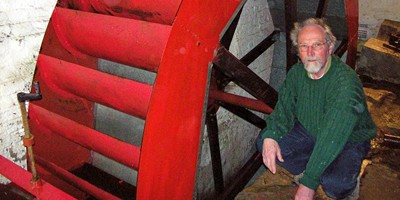
We offer our congratulations today to one of Bourne’s tireless voluntary
workers, Jim Jones, who has been named by the Queen in her Birthday Honours for
services to the community with the award of the MBE. This decoration is well
deserved for someone who has devoted the past 30 years for the benefit of the
public, in particular the Heritage Centre at Baldock’s Mill in South Street.
Without him, many of the projects would not have come to fruition and in past
years he has spent most of his spare time helping to make the centre such a
success. It began with the conversion work from mill to museum followed by the
establishment of a permanent gallery to the memory of the international racing
car driver and designer, Raymond Mays (1899-1980) who was born in this town and
which attracts visitors from all parts of the world. He and his wife, Brenda,
were also the prime movers of an exhibition to mark Queen Elizabeth's Golden
Jubilee in June 2002 and much of the work was carried out by them, including
giving the building a spring clean, fresh paint on many of the walls, and new
displays.
In May 2002, the couple received the The Local newspaper's Rose Award for
their dedication to the Civic Society and to the countless hours they spent in
keeping the mill in trim while their major achievement came in 2006 with the
opening of the Charles Worth Gallery devoted to the life and work of Charles
Worth (1825-95) who was also born here and achieved fame as a Paris fashion
designer and founder of haute couture. Jim and Brenda spent several weeks
fitting out the gallery and at one point even used their own money to pay some
of the bills in order that the project could be brought to a successful
conclusion. Not having an actual Worth dress, they visited the Victoria and
Albert Museum in London and obtained details of one of Worth’s creations and
then recruited a team of ladies who made a replica which is now one of the main
attractions of the display. The gallery has since been featured on television
several times and in 2007 was honoured by the Lincolnshire Renaissance Awards
when it was named as the best new exhibition in the county.
Jim and Brenda were both born in Liverpool but in 1976, when work
became scarce, they chose to move to Bourne with their two young
children to seek new opportunities. He had trained and worked as a qualified engineer
and soon life took on a different aspect, both through employment and
particularly through their outside activities. They became founder members of
the Civic Society in 1977 and since then Jim has served as a committee member
and unpaid custodian of the Heritage Centre since it was opened in 1981 while
Brenda is now chairman.
They keep the place clean and are often there at 6 a m polishing and sweeping
and are always in attendance for visitors, special groups and school parties who
wish to come outside hours. Jim also carries out most of the routine maintenance
work and often cleans out the Bourne Eau that runs past the building at the
back, while both can often be seen walking the area with black plastic bags
picking up wayside litter.
They are also active members of the Lincolnshire Wildlife Trust and the Abbey
Church in Bourne and fund raisers for the Lincolnshire Old Churches Trust, often
participating in their annual cycle ride around the parishes, taking in as many
churches as possible between 10 a m and 6 p m on a Saturday in late summer and
contributing to the trust's funds through sponsorship. In addition, Jim has
trained himself to use a laptop computer, digital camera and projector, to
enable him give illustrated talks to clubs and organisations on a variety of
heritage and conservation topics whenever required. He also designs the Civic
Society and Heritage Centre literature and has produced a set of postcards for
sale to aid society funds.
Jim is now retired and has just celebrated his 70th birthday but continues with
his voluntary work, always on hand with practical help and advice, a
perfect example to all small towns which thrive on enthusiasm and unpaid
assistance to keep its various organisations running. His MBE is therefore well
deserved and the award is equally bestowed on Brenda, in spirit if not in name,
in recognition of their unselfish and dedicated service to the community over
the past three decades and to those people and organisations with which they are
associated because they are also honoured.
After ten years of neglect, work has begun cleaning up Wherry’s Lane, the
main pedestrian route between the town centre in North Street and the Burghley
Street car park. In the past few days, workmen have been busy removing the
detritus of a decade that has piled up alongside the western end of the pathway
that has created a major eyesore.
A sample of the discarded rubbish that has accumulated includes a television
set, piping, self-setting shrubs and trees, beer and soft drink cans, takeaway
cartons, rotting fast food, plastic bags and an assortment of unmentionable
items that should have been removed long ago. As it is, all appeals to clean up
this eyesore have been consistently ignored by the local authorities although we
ought to be thankful that the problem is now being addressed.
The worst affected area is alongside the old workshops in Burghley Street that
have recently been purchased by South Kesteven District Council as part of a
£285,000 property acquisition in readiness for the redevelopment of the town
centre. When the deal was finalised in April, the leader, Councillor Linda Neal
(Bourne West), promised that this difficulty would be addressed. “Until now, the
council has been limited in its powers to tidy up”, she said, “but we can now go
ahead with the process and clear up this terrible mess.”
There is another equally disturbing problem that has been persisting in Bourne for
several years and that is the road surface along Pinfold Lane which has been a
hazard for motorists over a similar period. The section towards Manning Road is
riddled with deep pot holes that require slow and careful driving to pass
without damaging the car yet despite repeated complaints, only superficial
maintenance has been carried out and as of this week the surface is as dangerous
as it has ever been. It appears that this section of road is unadopted and
ownership in doubt yet both staff and customers of Anglia Home Furnishings and
users of the public waste facility pass this way as though it were a public road
and so someone should be responsible for the urgent repairs that are required.
As with the rubbish in Wherry’s Lane, this problem has been rumbling on for many
years and as the waste depot has become one of the busiest places in Bourne
since it opened in April 2002, the possibility of mishaps is ever present. The
facility is administered by Lincolnshire County Council which is also the
highways authority and so it is their responsibility to ensure that those who go
there do so safely. If their duties do not legally extend to this section, then
perhaps this is the time to tackle this anomaly and formally adopt the road in
order that repairs can be carried out to safeguard drivers. It would be no more
than an hour's work for a couple of men with a lorry load of tarmac but the
effort could save someone from a nasty accident. We have two newly elected
county councillors and perhaps this could be a worthy project that would benefit
the town they represent and show that they mean business in the future.
The implications of the term high density housing appear to have changed
with the years for whereas half a dozen homes to the acre was once the norm,
even for council houses, the current practice is to cram in as many as possible.
Beech Avenue, for instance, is probably one of our best laid out residential
estates of the post-war era yet thirty years ago there were concerns that this
too was perhaps becoming too crowded.
The debate over high density housing in Bourne has been intensified with the
granting of planning permission for the laundry site in Manning Road where 47
new homes are to be crammed on to a site of under two acres (0.7 hectares)
despite protests from the town council and elsewhere and we need to look back to
see whether this would have been acceptable in past times.
In June 1975, concern was expressed over a planning application to build 254 new
homes on a 30-acre greenfield site as an extension to the Beech Avenue estate
and it does not need a mathematical genius to work out the difference between
the two schemes yet there were concerns about high density building even then.
Houses, bungalows and chalets were included in the plans which suggested eight
properties per acre compared with 23 per acre for the Manning Road development
today.
Councillor Michael Taylor, later Mayor of Bourne for 1976-77, was particularly
scathing in his criticism of the scheme when it came before the town council for
discussion. “We have been dissatisfied with similar heavy density building in
the past but it has got us nowhere”, he said. The chairman of the planning
committee, Councillor Eddie Horn, was also disturbed. “We can do nothing about
it”, he said. “These housing estates should not go up ad hoc and we should
insist on seeing how many houses there are to be to the acre.”
These criticisms are almost identical to those from the council chamber today
and nothing seems to have changed. In the event the project was given planning
permission and the estate is now complete for all to see. But we need to ask why
this situation has been allowed to develop and worsen over the years whereas the
conditions surrounding house building should have improved. Government policy is
immediately to blame coupled with a weakening in the authority of the elected
councillor who has become emasculated as power has passed to the paid officials.
This has enabled developers to gain the upper hand and they now more or less
dictate when and where they want to build.
It had been hoped that the economic downturn might reverse the trend but
although building at the previous pace has largely been halted, plans continue
to appear which indicate that once the recession is over, things will continue
more or less as before which does not auger well for Bourne. This is a small
Lincolnshire market town that would have benefited from organic growth, that is
a gradual rate of house building that kept pace with the provision of amenities
and facilities, but the reverse is true which indicates that those who oversee
these matters are either ignorant of the implications of forced expansion or are
deliberately using the town to dump as many unwanted housing estates on it as
possible merely to generate additional revenue from the council tax.
There is another cautionary tale from the 1975 housing development because the
Beech Avenue scheme also included provision for a shopping centre and
recreational facilities but you will look in vain for either of these amenities
today.
Thought for the week: It is an immutable law in business that words are
words, explanations are explanations, promises are promises but only performance
is reality. - Harold "Hal" Sydney Geneen (1910-97), English-born American
businessman most famous for serving as president of the multi-national
conglomerate ITT Corporation.
Saturday 20th June 2009
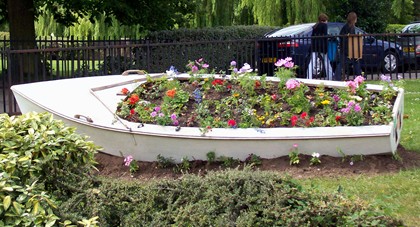
New floral feature - see "Bourne is pushing the boat out . . .
"
A glowing picture of the water cress industry at Alresford in Hampshire
is painted in the travel section of The Times where it is described as “the
perfect English town” (April 11th). Generations of locals knew that the clear
waters of the River Arle provided ideal growing conditions for the crop which
was sold to neighbouring villages but the arrival of the railway in 1865 meant
that this year-round salad vegetable could be transported to Waterloo in the
afternoon and be on sale at Covent Garden next morning.
So it is today for although the railway closed in 1973 it was opened again in
1985 by a band of volunteers and the Mid-Hants Railway, or the Watercress Line
as it is known, now runs for ten miles into the neighbouring town of Alton where
it connects with the mainline services. This could have been Bourne because
watercress was also an important part of the local economy in past times. The
healthy green crop is particularly suited to those places in England where there
is an abundant supply of flowing water that was necessary for its production and
the natural springs rising at the Wellhead provided the perfect conditions.
Our own watercress industry was established by Edwin Nathaniel Moody in 1896 on
land adjoining St Peter’s Pool and production soon became so prolific that
wholesale supplies were regularly sent by rail to markets in London and
Leicester. By 1911, output was at its peak and further plantations were
established at the rear of Harrington Street, land that is now Baldwin Grove,
and at Kate’s Bridge. The cress beds were eventually taken over by Spalding
Urban District Council in 1955 who kept them going until 1969 when they were
bought by the South Lincolnshire Water Board who continued to run them until
April 1974 when they were closed down and filled in and so an important industry
was lost to the town.
This is a pity because as is being proved at Alresford, water cress is enjoying
a new reputation as one of the healthiest foods you can possibly eat, rich in
vitamins and other nutrients, and would therefore be a welcome addition to our
diet if the locally grown product were immediately available, bunched and
freshly picked, rather than the packaged variety from the supermarkets which, I
am advised, is less beneficial.
There remains however another major difference between Alresford and Bourne. “A
walk alongside the River Arle is essential”, says the newspaper article, “and it
is difficult to imagine finding cleaner water this side of an Alpine stream.”
Unfortunately the same cannot always be said of the Bourne Eau today although
members of the Civic Society have taken matters into their own hands and have
been busy in recent weeks cleaning out the waterway in readiness for the
forthcoming East Midlands in Bloom competition.
The railway system in Bourne closed down in 1959 after serving the
town for almost a hundred years and has been regretted ever since. If the lines
had remained open, the benefits to the town can only be imagined, for business
and commerce as well as the travelling public who would have had the advantage
of connections with the main east coast line between London and Scotland, East
Anglia and the Midlands, so enabling the movement of freight and trips out for
shopping and the theatre as well as the seaside on sunny days.
Instead, all travel is concentrated on the roads with the car taking precedence,
its presence despoiling our town centres and urban streets. The Beeching axe
which followed in 1963 was undoubtedly one of the greatest acts of national
vandalism perpetrated during the 20th century by reducing the country’s rail
network by one third, destroying freight and passenger services that had served
the country well for more than a hundred years, making 5,000 miles of track
redundant and closing 2,000 traditional railway stations that had become the
very essence of rural England.
The passing of the railway age is mourned in many places and, as at Alresford
and elsewhere, volunteers fight valiant battles to re-establish what we have
lost and so many short stretches of line are being reopened to provide a
valuable public service as well as tourist attraction as the old locomotives
steam again along routes that we thought had been closed forever. Even today’s
train operators are now realising that these relics of the past may still have a
use and are calling for the opening of 14 lines and 40 stations as part of a
£500 million expansion of the existing rail network.
The proposal is not altruistic, however, and the Association of Train Operating
Companies (Atoc) says that such a move could serve more than one million extra
passengers and encourage many more to switch from road to rail (BBC Online,
June 15th) . “There is a strong case for investment to bring a number of towns
back on to the rail network”, said chief executive Michael Roberts. Oh, what a
benefit hindsight would have been half a century ago.
Further security precautions to deter intruders that are being taken
around the town are an indication that we are fast approaching a Fortress Bourne
mentality in our attitude towards the prevention of vandalism and criminal
damage. The latest safety measures have been taken by Bourne Town Football Club
which is barricading the windows of its clubhouse at the Abbey Lawn after eight
of them in the dressing rooms were smashed during a night time incident last
month causing damage in excess of £1,600. A single such occurrence might be
easier to bear but these premises have been targeted time and time again during
the past ten years and the club committee has now decided that enough is enough.
Their spokesman Rob Lambert told The Local newspaper (June 12th) that
they were sick and tired of cleaning up after these outbreaks which on the
experience of past years were likely to become more frequent during the lighter
evenings of the summer months. “They appear to be fuelled by drink because there
are always bottles and cans everywhere”, he said. “We are powerless to do
anything and the situation is getting worse every year. It is costing us a lot
of money to repair the damage while at the same time the club’s insurance
premiums are going up because we make so many claims. We have therefore decided
to board up the windows for the time being.”
The trustees of Bourne United Charities which administers the Abbey Lawn are
currently employing security guards to patrol the grounds although planning
permission has now been given for the entire site to be enclosed by 9 ft. high
railings which are due to be installed later this year. The design appears to
blend with the surroundings but it is nevertheless a metal barrier that will
enclose the grounds and may even be accompanied by a night time curfew, thus
excluding the public for the first time in two centuries.
The windows of Bourne Cricket Club’s headquarters at the Abbey Lawn are already
boarded up and the clubhouse at the bowls club on the other side of the grounds
has protective iron bars while barbed wire surrounds the adjoining outdoor
swimming pool to deter intruders while there are also other signs around the
town of similar security precautions as vandalism continues, notably at shops
and business premises, many of which are now protected when closed by iron
grilles, high metal gates and padlocks. The Post Office in West Street has been
fitted with spiked metal rails along its perimeter wall to stop anyone getting in and
Anglian Water has recently installed what looks like razor wire around its
pumping station depot in Manning Road. Few public access buildings do not have
similar protection while the installation of intruder alarms at domestic
properties proliferates.
The erection of the Abbey Lawn fencing has already been described by the town
council as “a sad day for Bourne” and with the other defences that can be seen
around the town are a gloomy commentary on society today. Popular opinion has
been repeatedly in favour of policemen back on the beat, as we had in past
times, to combat both vandalism and anti-social behaviour because a uniformed
presence is currently a rare sight in Bourne except for a patrol car passing
through on the way to somewhere else. The culprits too, when apprehended, are
treated too lightly and most people would like to see tougher sentences for
those who damage and destroy public property. But all of these criticisms have
been made before and nothing is done and so the football club committee and
other victims wring their hands in despair and Fortress Bourne becomes more of a
reality with each passing day.
Bourne is pushing the boat out in its attempt to win a gold award in this
year’s East Midlands in Bloom competition which is due to be judged next month.
Everywhere you look there are improvements to the town and no one can fail to be
impressed by the work that is underway into making it as attractive as possible
for the summer ahead.
The latest feature has just been completed in South Street on a patch of lawn
between the Darby and Joan Club and the Bourne Eau which until now has been
occupied only by a public seat. The centrepiece is a 14 ft. Enterprise sailing
dinghy that has been presented by Tony Everitt who is the quartermaster of the
1st Bourne Scout Group and teaches the lads sailing at the Whitewater Reservoir
near Stamford. “The boat is about fifty years old and made of wood and so it is
rather past its prime for our purposes”, he explained, “but it is perfect in its
new role in a floral display.”
Tony, aged 65, who has been associated with the scout movement for almost half a century,
arranged for the craft to be delivered to its new site and organised the soil
while Year 7 pupils from the gardening club at the Robert Manning College
brought along plants they had grown themselves. Other volunteers from the Bourne
in Bloom committee were there to lend a hand while the future maintenance and
watering will be undertaken by the Learning Disability Group. This project has
not only added a colourful feature to the street scene but has also demonstrated
the value of volunteers and groups working together for the good of the
community which will also have long term effects because the boat is to remain
in situ for the future and will be replanted with seasonal flowers throughout
the year.
The East Midlands in Bloom competition is due to be judged during an unannounced
visit sometime between Monday 6th and Friday 17th July and Bourne is competing
in the section for Category B towns, those with a population of between 6,000
and 12,000, based on the last electoral register. This event has now become an
annual effort to make the streets, gardens and open spaces look their best in
the hope of impressing the judges when they arrive and of making Bourne an
attractive place for visitors and those who live here. We have already been
honoured three times in recent years with silver awards in 2006, our first entry
for thirty years, and again in 2007, followed by a silver gilt in 2008, and
there are high hopes that a coveted gold may eventually come our way, perhaps
even this year.
Thought for the week: Flowers are a proud assertion that a ray of beauty
outvalues all the utilities of the world. - Ralph Waldo Emerson (1803-82),
American poet, lecturer and essayist.
Saturday 27th June 2009
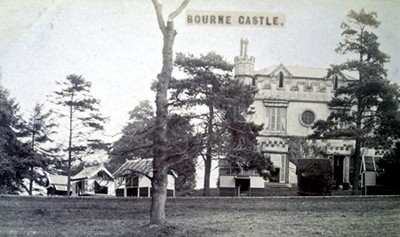
Bourne Castle - see "The existence of . . . "
The possibility of the proposed new medical centre
planned for a site on the Southfield Business Park actually materialising
appears to recede with each meeting of South Kesteven District Council’s
planning committee. The much needed amenity was top of the agenda when the
health care scheme was first submitted back in 2006 but it is now taking second
place to more housing for the elderly which this town does not need and, more
importantly, cannot handle.
It will be remembered that the original scheme by the Leeds-based company One
Medical included a centre offering a wide range of services from general
practitioner appointments and dentistry to home care for the elderly and
mentally ill which would help meet the shortfall in hospital services for the
town following the closure of Bourne Hospital in 1998 and create 200 new jobs (Stamford
Mercury, 4th August 2006).
In the event, the company submitted two planning applications, one a detailed
scheme for a care home and sheltered accommodation and another seeking outline
permission for the medical centre which suggested that it was ready to proceed
with the first but not quite ready for the second which is exactly what
happened. The Local now reports (June 19th) that the flats were completed
in October but there is still no firm date when the medical centre is likely to
be built. Instead, the company has been given the go-ahead for work to start on
another 88-bedroom old people’s home at a cost of £4.5 million which is likely
to be finished by next summer, providing 24-hour nursing care for people who are
bedridden or need regular medical attention.
These projects may well have a place in the Bourne of the future but at the
moment there are other new housing schemes for the elderly around the town that
are still not fully occupied while the additional numbers of residents moving in
from outside the area are taxing our already overstretched medical facilities.
As this column pointed out when the original planning application was submitted
three years ago, building the flats before the medical centre is putting the
cart before the horse and SKDC should have stipulated a preference as a
condition of the planning permission.
Too many of our planning applications are littered with good intentions and the
council has still not explained whether the doctor’s surgery promised for Elsea
Park across the road is likely to materialise or whether this scheme will now
replace it. Those who followed the negotiations at the time will remember that
this medical facility was part of the planning gain package agreed with the
developers in November 1999 in return for permission to build the 2,000 house
estate. A new south west relief road that was also agreed has been opened after
much aggravation but the new primary school which was also included has been
shelved and there is no sign yet of the promised multi-purpose community hall
and sports pitches. It would be shameful if the proposed new medical centre
planned for the Southfield Business Park were to suffer the same fate.
The unsightly appearance of wheelie bins littering the streets and
gardens of our towns and villages has resulted in a national campaign to allow
council tax payers choose whether they should have ordinary dustbins or
biodegradable bags instead. The revolt comes amid a growing resentment at the
sight of these plastic monsters blighting the urban landscape after local
authorities pushed through unwanted changes to the rubbish collection
arrangements despite widespread public protest.
Wheelie bins were introduced in Bourne during the autumn of 2006 as part of a
£2.7 million recycling initiative by South Kesteven District Council, with two
being issued to each of the 55,000 households in its area, silver for recyclable
and black for household waste. The new system has been one of the most
controversial public service issues of recent years and despite claims that it
had been approved through consultation, figures for this exercise have never
been released and there have been widespread complaints that the containers are
too big and bulky and many homes have no space to store them with the result
that they are blocking side passages and even left in front gardens. Terraced
houses such as those in the Austerby, Hereward Street, Meadowgate, Elm Street,
Burghley Street and St Peter’s Road face particular difficulties and even today,
almost three years after their introduction, bins can be seen permanently from
the highway at many prominent locations, creating an unsightly appearance in the
street scene.
The Daily Mail (June 18th) has now called on our local authorities to
stop pushing through unwanted changes to rubbish collection regimes which in
Bourne has resulted in the axing of the weekly collections for the first time
since they were introduced more than a century ago. Opponents of wheelie bins
stress that they are not against recycling but claim that the bins are totally
unsuitable for millions of homes yet councils have ignored protests, petitions
and even marches and are enforcing the new system through coercion and heavy
fines for those who do not comply with the stringent regulations attached to
their use.
The introduction of the kerbside wheelie bins is also likely to see an end to
yet another public amenity, the waste recycling banks which can be found at 43
locations throughout the South Kesteven district but the council claims that as
more is being redirected from landfill to recycling and composting, they have
become dispensable whereas anyone who uses them knows that they still provide a
valuable service, especially to those households with large families which
generate more rubbish than the silver bin can hold.
Bourne is a small market town that has grown up around a traditional market
place with four main streets meeting at a central crossroads and most of
the properties which pre-date the motor car are small and inaccessible for large
vehicles while the restrictions on space leave no provision for receptacles of
this size. In addition, the bins are unwieldy and hard for old people to handle
yet none of these drawbacks appear to have been addressed by those councils
which pushed through the new scheme come what may while turning a deaf ear to
the howls of protest.
Perhaps the most scathing comment about their introduction without serious
thought on the complications they have created comes from the art historian Sir
Roy Strong who told the newspaper: “Hasn’t anyone talked to a designer about
these things? They are awful and they are multiplying like rabbits. It is total
thoughtlessness.”
The existence of a castle in Bourne in past times remains an elusive
prospect although reminders surface occasionally but these are often little more
than a joke. A picture postcard, for instance, that arrived this week from
Hampshire suggests that one might have existed in the late 19th or early 20th
century. The photograph shows a country mansion with battlements and a tower and
is clearly captioned Bourne Castle but whether this is an architectural folly
from Victorian times or a large house with a plywood façade and other
embellishments added for some special occasion is anyone’s guess. Neither is
there any indication whether this is, in fact, our Bourne.
It was sent by Neil Beattie of Axford, near Basingstoke, who tells me that he
found it in an album of 650 postcards collected between 1905 and 1920 inherited
from an elderly friend who died with no family. They had been amassed by his
parents, Mr Jessie Coakes and his wife, Verina, who had travelled extensively
throughout Britain with Jessie working as a gamekeeper and Verina as a nurse,
often in different parts of the country, hence the many postcards. Several
feature views of Lincolnshire from 1905 when Jessie was apparently being
interviewed for a job, which presumably he did not get. “We have no reason to
connect the Bourne Castle view with Lincolnshire other than the existence of
your town and these few postcards“, said Neil. “It could equally be anywhere in
the country.”
The back of the postcard does not have the name of a publisher, as many do,
which would have helped to identify the location and it has not been postally
used so there is no telltale postmark either. The huts around the property are
also intriguing and if this was a camp of some kind, then we wonder why they are
situated so close to the house. I am printing the picture in the hope that
someone might he able to shed some light on its location. Unfortunately, it will
not add to our knowledge of the real Bourne Castle, if indeed it ever existed a
thousand years ago, but at least it may help solve this small mystery that has
surfaced in a postcard album from a century ago.
A plaque has finally
been installed in the town to the memory of Frederic Manning, the
Australian poet and author who wrote one of the finest novels to emerge from the
horrors of the Great War of 1914-18.
The location chosen is the front wall of the
Burghley Arms where the writer lived for many months in those days when it was
known as the Bull Hotel. Although in failing health and latterly surrounded by
oxygen cylinders to aid his breathing, Manning penned the draft of his novel The
Middle Parts of Fortune which was published first anonymously and then to high
acclaim as Her Privates We, a distinguished work that is still in print today.
The circular plaque has cost £400 and has been financed with the
support of Bourne Town Council, a tasteful work in blue with gilt lettering, as
a reminder to those who pass by the man who laboured within to produce such a
fine book.
Manning (1882-1935) served during the war and his novel is a
harrowing account of the horrors of trench life seen through the eyes of Private
Bourne, the hero he named after this town, and is reckoned to be among the most
important literary works to emanate from the conflict of 1914-18 which claimed
ten million lives. He lived here in 1929, first at the Bull Inn but later moved
in as a lodger with a couple in Burghley Street and during this period, he
developed such a fondness for the town that he stayed here until shortly before
he died in a London nursing home.
The writer is not universally known and he has been confused with Robert Manning
(1264-1340), the mediaeval monk who worked at Bourne Abbey producing religious
texts, thus setting a standard of Middle England speech and dialect, and is also
well remembered with the Robert Manning College as well as having a road named
after him. But Bourne is not blessed with too many connections with the famous
and so a plaque for this particular literary association is a welcome addition
to the tourist trail that many visitors take when exploring the town.
The plaque has been a long time in coming and bears the date 2007 when it was
first discussed by the town council and it was hoped that there would be an
official unveiling ceremony on July 22nd that year to coincide with the 125th
anniversary of his birth, perhaps with someone from the Australian High
Commission in London present, but this has not been possible. Manning was from
all accounts a shy and retiring person and so the appearance of his memorial
quietly and without fuss and undue ceremony may have met with his approval.
Thought for the week: I awoke one morning and found myself famous.
-
Lord (George Gordon Noel) Byron (1788-1824), the 6th baron, one of the great
English poets and a leading figure in Romanticism who remains widely read and
influential throughout the world.
Return to Monthly entries
|



